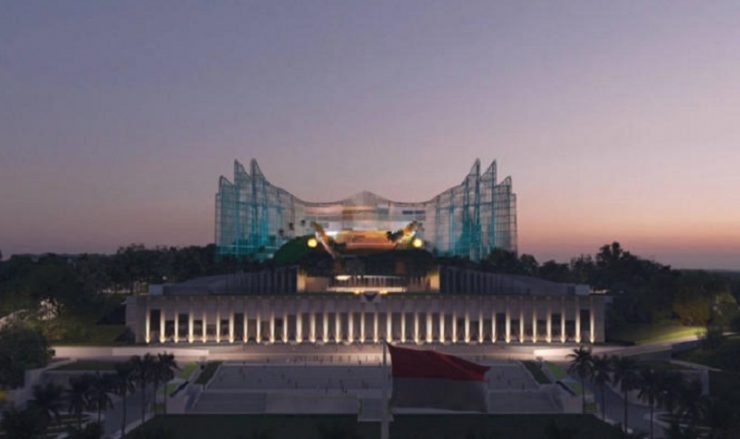THE DEVELOPMENT of the National Capital City (IKN) of the Archipelago in East Kalimantan Province, initiated by former President Joko Widodo, is a beacon project for the infrastructure sector and the most controversial in post-reform Indonesian history.
Initially proposed as a geopolitical solution and territorial development by slowly moving some government functions out of Jakarta, it transformed into a political project that was inherited and contested between regimes.
Now, the issuance of Presidential Regulation (Perpres) no. 79 of 2025 concerning Updates to the Government Work Plan for 2025 confirms President Prabowo Subianto’s leadership position in continuing development and setting a target for IKN to become the “political capital” by 2028. Of course, this is a big question for all of us: What is the political meaning of IKN? Does IKN really deserve to be the new center of power? With such enormous costs and consequences, what kind of future awaits?
Although it is said that the IKN lighthouse project is being promoted as a “smart” and “sustainable city” that will become the center of modern government as well as a catalyst for development in the Eastern region. The previous government carved it out as a strategic project through several key infrastructures, for example the IKN State Palace and several public facilities were inaugurated towards the end of President Jokowi’s term of office.
The narrative constructed by pro-government, IKN is evidence of a decentralized development vision that wants to reduce the burden on Jakarta and encourage economic equality.
On the other hand, ambitious projects are always related to budget planning which requires large and massive amounts. The government on various occasions has stated large figures for total needs, but the sources and assumptions vary. The Deputy of the Presidential Staff Office (KSP) once stated that the development needs scenario is around IDR466 trillion, noting that not all of it will be charged to the APBN (State Revenue and Expenditure Budget).
Budget realization in the field shows a significant flow of public funds, public records state that actual IKN spending reached IDR72.3 trillion for the 2022-2024 period, while the annual APBN allocation increased sharply (for example around IDR43.3 trillion in 2024 according to government recaps and media reports). This figure shows that IKN is not a small-cost project, but rather a fiscal project that consumes large-scale public resources.
On the other hand, the new government under the leadership of President Prabowo Subianto has issued Presidential Decree 79/2026, emphasizing the continuation of development until the target of transforming IKN into a “political capital” in 2028 which is a political signal that IKN will not be abandoned as a mere administrative project.
This decision provided medium-term policy certainty, but also moved the debate into other areas, such as budget priorities, political legitimacy, and technical/environmental feasibility.
Pros and Cons of the IKN Mega Project
A number of supporters point out several main claims about the importance of sustainable IKN development. First, moving the capital city can reduce Jakarta’s burdens (such as density, congestion, flooding and pollution) so that the dense city on the island of Java can “breathe”. Second, IKN becomes a tool for equality through infrastructure development in Kalimantan which is expected to open up space for a multiplier effect (employment, increase in local GDPR and access to public services).
Then, IKN is positioned as a city of the future (smart and green city) that integrates sustainable spatial planning, digital government technology, and new governance—a model that is expected to become a laboratory for modern public policy. A number of politicians and economists believe that if managed well, IKN can encourage economic redistribution and support long-term national stability.
On the other hand, in view of geopolitical arguments, moving the center of government to an area close to eastern Indonesia will increase regional control, strengthen sovereignty, and reduce dependence on infrastructure centered in Java. For a large and archipelagic country like Indonesia, diversification of development centers is considered reasonable by some planning experts.
However, criticism of IKN was no less harsh. The main criticism of high costs and uncertain benefits raises a question: Would the hundreds of trillions of rupiah poured in be more effectively used to improve public services across the province, including in densely populated Java?
Reports by journalists and international research institutions point to delays, land acquisition problems, as well as a lack of foreign investors coming in as projected, raising questions about whether economic growth expectations are realistic. The Financial Times and Reuters noted that investment problems, logistical obstacles and unpreparedness of facilities occurred as the project was driven ahead of the transition of power.
From an environmental perspective, the IKN area—which is located in a tropical forest and high carbon ecosystem—is subject to major development that triggers deforestation, habitat fragmentation and the risk of land fires. Environmental critics say IKN’s “green” promises often clash with the reality of development which requires land, roads and facilities.
A number of environmental institutions and academics have warned of possible social-ecological impacts for indigenous peoples and local communities who lose access to land or traditional sources of life. Critical studies highlight that some “sustainable city” claims have not been supported by adequate environmental studies or transparent public participation.
Aspects of governance and democracy also raise question marks. The IKN project was launched relatively quickly, with a planning process that according to some researchers did not involve broad public participation.
The lack of transparency in some land decisions and contracts raises issues of corporatization of public space and potential land speculation, a phenomenon that has been reported by the media and civil society organizations. This criticism underscores the risk that IKN becomes a top-down project that ignores the voices of local communities.
The meaning of IKN as “Political Capital”: Opportunities and Challenges
The label “political capital” implies that IKN is not only seen as an administrative center (offices, ministries, palaces), but a center of power that determines the national political agenda (policy making, political lobbying, and a symbol of state legitimacy).
Becoming a political capital means that political actors will adjust their map of influence (bureaucrats, political parties, corporations and international actors). Therefore, IKN’s position has implications for the distribution of political resources. If IKN is effective as a clean and responsive political center, it can improve governance.
However, if IKN becomes a new patronage arena, the transfer will only be a transfer, not solving old political problems. The Presidential Decree which sets the 2028 target for the political transition to IKN confirms this ambition, but demands strict public supervision so that the new political role is accountable. If managed wisely, IKN can present several opportunities.
Firstly, governance policy experiments. IKN could become a pilot project for green space policies, electric public transportation and digital governance which, if successful, could be replicated in other cities.
Secondly, inclusive development. Putting in place a process of involving indigenous communities and a fair compensation scheme, IKN can test a development model that respects local rights.
Thirdly, the innovation and research center. Placing research institutions and think tanks at IKN can strengthen the capacity for evidence-based policy making, including climate adaptation and social justice.
So that opportunities are not only seen as mere rhetoric, but the challenges also that must be overcome includes: Firstly, fiscal sustainability. Balancing public spending with real results by avoiding financing that drives deficits or compromises basic social programs. Initial spending data must be rigorously evaluated by an independent audit.
Secondly, environmental guarantees. This point emphasizes the implementation of a comprehensive AMDAL study, a moratorium on new land clearing without community consent, and an ecosystem restoration plan.
Then, democratic participation. Strengthen public consultation mechanisms, open contracts, and legal protection for indigenous communities and local farmers. Fourth, anti-speculation land management. Adopt regulations that prevent land grabbing and speculation in land values that impoverish local residents.
Considering Big Political Decisions
IKN is a national scale project, containing promises and risks at the same time. Placing it as the “political capital” is a strategic decision that is not merely about moving government offices, but rather about how the country maps development, distributes power, and enforces accountability to the people. The new presidential decree confirms the continuation of IKN until 2028, providing certainty regarding policy.
However, certainty must be balanced with budget transparency, environmental protection and public participation so that IKN does not end up becoming a mega-project monument without broad benefits and solutions.
Apart from the pros and cons, an important question arises: Will IKN be a tool to improve governance and people’s welfare or is it just a transfer of political symbols that strengthens a new center of power? The answer to that question will determine whether IKN’s legacy is truly a triumph of equitable development or just a project that is expensive, but fragile in its social legitimacy. [kumparan.com/photo special]
















